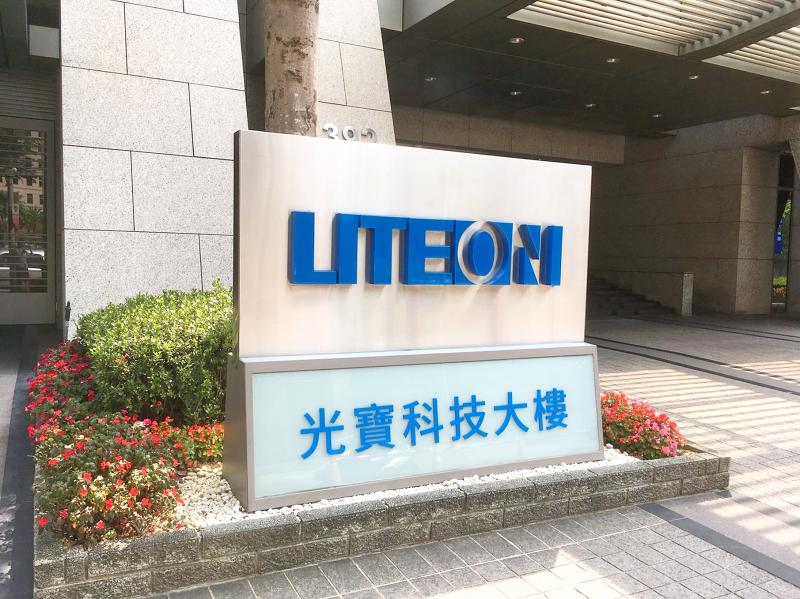Lite-On Technology Corp (光寶科技) yesterday reported its highest earnings per share (EPS) in five years for the October-to-December quarter, thanks to an improved product mix and operating efficiency, the electronic components supplier said in a statement.
The company posted fourth-quarter net profit of NT$2.51 billion (US$90.05 million), up 25 percent from a year earlier, but down 19 percent from the previous quarter on revenue of NT$44.57 billion. It was also up 8 percent year-on-year and 6 percent quarter-on-quarter.
Lite-On attributed the annual increases to steady growth in demand for products used in optoelectronics, cloud computing, 5G, artificial intelligence of things (AIoT) and automotive applications.

Photo: Chen Rou-chen, Taipei Times
EPS reached NT$1.11 in the quarter, the highest for the October-to-December period over the past five years, as gross margin and operating margin improved to 17.3 and 8.1 percent respectively, up from 16.2 and 4.4 percent a year earlier.
That brought last year’s total net profit to NT$13.89 billion, up 39 percent from 2020, with EPS rising from NT$4.31 to NT$6.01, a record, Lite-On said.
Gross margin increased 1.1 percentage points annually to 18.5 percent, while operating margin rose 1.4 percentage points to 7.9 percent, it said.
“Due to continually optimizing our product mix, improving our flexibility and response times through smart manufacturing and supply-chain management, and boosting our operational efficiency, 2021 resulted in a record profit margin and EPS,” the statement said.
Lite-On reported revenue of NT$164.83 billion for the whole of last year, up 5 percent from a year earlier.
The increase is as high as 10 percent if a business transfer in 2020 is excluded, said the company, which sold its solid-state drive business to Japan’s Kioxia Holdings Corp on July 1, 2020.
Last year, Lite-On’s optoelectronics segment contributed 20 percent of its total revenue, while the cloud computing and AIoT segment contributed 27 percent, and the information technology and consumer electronics segment contributed 53 percent.
The company continues to implement a market-oriented strategy, and expanded research and development by more than 20 percent last year, especially in optoelectronics, cloud computing, automotive electronics, and 5G and AIoT products, Lite-On president Anson Chiu (邱森彬) said.
Although its business model has shifted from original equipment manufacturing and original design manufacturing, the company aims to offer customers a systematic solution through in-house product development, Chiu said.
“Automotive electronics and 5G/AIOT products continued to obtain customer certifications in the past two years,” Chiu said in the statement. “As market momentum continues to grow, they will become the growth drivers for Lite-On.”
The company also aims to expand into smart grid solutions for household energy management in the medium to long term, creating a new growth driver, it said.

Intel Corp chief executive officer Lip-Bu Tan (陳立武) is expected to meet with Taiwanese suppliers next month in conjunction with the opening of the Computex Taipei trade show, supply chain sources said on Monday. The visit, the first for Tan to Taiwan since assuming his new post last month, would be aimed at enhancing Intel’s ties with suppliers in Taiwan as he attempts to help turn around the struggling US chipmaker, the sources said. Tan is to hold a banquet to celebrate Intel’s 40-year presence in Taiwan before Computex opens on May 20 and invite dozens of Taiwanese suppliers to exchange views

Application-specific integrated circuit designer Faraday Technology Corp (智原) yesterday said that although revenue this quarter would decline 30 percent from last quarter, it retained its full-year forecast of revenue growth of 100 percent. The company attributed the quarterly drop to a slowdown in customers’ production of chips using Faraday’s advanced packaging technology. The company is still confident about its revenue growth this year, given its strong “design-win” — or the projects it won to help customers design their chips, Faraday president Steve Wang (王國雍) told an online earnings conference. “The design-win this year is better than we expected. We believe we will win

Chizuko Kimura has become the first female sushi chef in the world to win a Michelin star, fulfilling a promise she made to her dying husband to continue his legacy. The 54-year-old Japanese chef regained the Michelin star her late husband, Shunei Kimura, won three years ago for their Sushi Shunei restaurant in Paris. For Shunei Kimura, the star was a dream come true. However, the joy was short-lived. He died from cancer just three months later in June 2022. He was 65. The following year, the restaurant in the heart of Montmartre lost its star rating. Chizuko Kimura insisted that the new star is still down

While China’s leaders use their economic and political might to fight US President Donald Trump’s trade war “to the end,” its army of social media soldiers are embarking on a more humorous campaign online. Trump’s tariff blitz has seen Washington and Beijing impose eye-watering duties on imports from the other, fanning a standoff between the economic superpowers that has sparked global recession fears and sent markets into a tailspin. Trump says his policy is a response to years of being “ripped off” by other countries and aims to bring manufacturing to the US, forcing companies to employ US workers. However, China’s online warriors